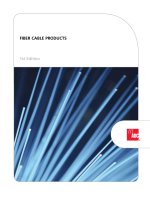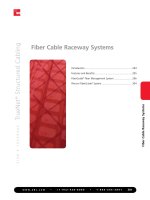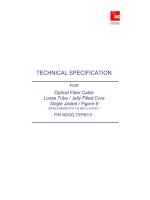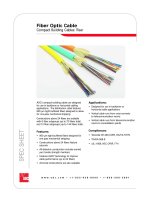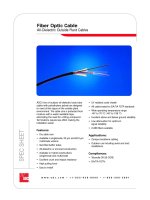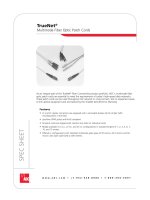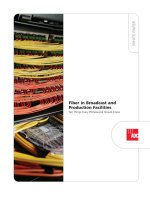Tài liệu ADC KRONE - Guide - FO - The challenge in using APC connector ppt
Bạn đang xem bản rút gọn của tài liệu. Xem và tải ngay bản đầy đủ của tài liệu tại đây (70.71 KB, 6 trang )
white paper
The Challenges of Apex
Fiber optic connectors provide a low loss means of connecting optical circuits. Low loss is achieved by
minimizing the lateral offset between optical fibers and by maintaining physical contact between the
optical fibers. Physical contact can be achieved when the ferrules containing the optical fibers have a
convex spherical polish on the endface. By having the apex of the spherical polish coincide with the
center of the ferrule containing the optical fiber, the fibers have a high probability of achieving
physical contact when mated together. The parameters that define the endface geometry for a
physical contact (PC) ferrule are radius of curvature, height of the fiber with respect to the polished
radius, and the distance between the apex of the spherical polish and the center of the fiber
(apex offset).
The spherical polish of a ferrule can be applied at an angle to reduce reflectance of the connection.
The most common angle is 8°. Meeting the criteria for fiber height and radius are no more difficult
to do in an angled physical contact (APC) connector than a non-angled PC connector. However,
achieving low apex offsets proves to be a challenge when the ferrule is polished at an angle.
Offset in APC Connectors
Generally speaking, ferrules have a chamfer around the endface that is symmetric with the axis of
the ferrule (See Figure 1). When polished at 8°, material is not removed uniformly about the axis of
the ferrule (See Figure 2). Because the ferrule is tilted in polish, more material is removed from one
side of the ferrule axis than the other. As Figure 2 shows, the angle on the left of the chamfer is not
as steep relative to the angle on the right of the chamfer. As material is removed in polish, the
surface of the endface becomes relatively larger on the left of the ferrule axis as shown in Figure 2
than the right. Hence the center of the ferrule endface moves to the left, away from the ferrule axis.
When polished using a compliant rubber polishing pad, a convex spherical radius is put onto the
ferrule endface. The peak or apex of this radius will generally be at the center of the surface being
polished. The distance between the center of the fiber and the center of the spherical surface being
polished is the apex offset. Because this peak drifts away from the ferrule axis as more material is
removed, the apex offset will increase.
Figure 1
∝
∝
2
The relationship between apex offset and the angle the ferrule is being polished at is:
Where:
• y = Ferrule removal during polish, measured along the ferrule axis.
• x = Initial ferrule pedestal diameter
• θ= Desired ferrule angle (the angle the endface is viewed at in an interferometer)
•
α
= Ferrule chamfer angle
Figure 2
X
0
Y
R
∝
θ
Ferrule/Fiber
Centerline
Polished
Endface
Apex
Offset
Material
Removed in
Polish
(
)
(
)
ApexOffset =
y +
-
2tan
α
x
0
+ 2 y tan
α
x
0
sin (90 -
α +
θ
)
2 cos
θ
sin (
α)
3
For a given ferrule geometry (that is, a defined angle of polish, pedestal diameter, and chamfer angle),
there will be a minimum apex offset that can be achieved regardless of the quality of the fixtures or
methods used. In addition, as equation 1 shows, the more the ferrule is polished, the greater the apex
offset becomes.
Figure 3 shows how the apex offset will vary with the amount of ferrule material removed during
polish for several initial pedestal angles. As the plots show, the initial pedestal angle has the largest
affect on apex offset. But minimizing the ferrule chamfer is not easy because international
intermateability standards generally require chamfers of 32.5° to 37.5°. Given this, we see that it’s
impossible for an APC connector of this design to have an apex offset better than about 25 microns.
We have to consider variations in manufacturing processes when determining a maximum permissible
apex offset specification. If the polishing fixture had no variation between each connector position, one
could polish apex offsets with a minimum per Figure 3 and small variations above that point. But even
the best fixtures and processes have variation that will result in apex offsets greater than 50 microns if
the minimum possible apex offset is 25 microns. To achieve acceptable yields, the maximum permissible
apex offset needs to be greater than 50 microns. 65 microns will allow manufacturers to achieve high
yields while allowing connectors to maintain physical contact during extreme environmental conditions.
Considering that PC connectors have an apex offset range of 0-50 microns, having APC connectors
with a range of 25 –65 microns still requires a very consistent polishing process. Even though APC
connectors will have higher average apex offsets than PC connectors, variation in APC connectors
is reduced.
Apex Offset vs. Ferrule Material Removed for Various Ferrule Chamfers
0
10
20
30
40
50
60
70
80
90
100
0.00
0.05
0.10
0.15
0.20
0.25
0.30
0.35
0.40
0.45
0.50
Ferrule Material Removed in Polishing (mm)
Apex Offset (microns)
Chamfer = 20∞ Chamfer = 30∞ Chamfer = 40∞
Figure 3 (For X
0
= .585 mm)
4
A 65 micron apex offset on APC connectors is acceptable for long-term environmental performance as
long as the fiber height is ±50 nanometers. International standards (Telcordia and IEC) require that apex
offset on APC connectors be less than 50 microns. But this assumes a fiber height of ±100 nm and a
radius of 5 mm to 12 mm. These requirements correctly recognize that if both fiber recess and apex
offset are too large for a given radius, physical contact could be lost from the pistoning of the fiber
within the ferrule. But if we reduce the minimum fiber height requirement, we can easily increase the
apex offset a small amount and maintain physical contact in temperatures as great as 85°C. It has also
been shown through experimentation that APC connectors with 65 micron apex offsets and –50nm
minimum fiber heights will pass the environmental requirements of Telcordia-GR-326. Given that the
minimum possible apex offset on APC connectors of this design is about 25 microns (unless other
methods are used), it makes sense to increase the maximum apex offset to 65 microns as it will not
inhibit connector performance and greatly increases manufacturing yields.
A method to achieve lower apex offsets is to have a ferrule whose chamfer is offset from the axis of the
ferrule by an angle equal to the endface angle. In this configuration material is removed at an equal
rate from both sides of the ferrule axis and no apex drift occurs. The result is that an apex offset of zero
is possible. However, if one wants to optimize the insertion loss of the connector via tuning, the
orientation of this offset is not known until after tuning. At this point it’s technically prohibitive to grind
on the chamfer of the ferrule. For any APC ferrule that is to be tuned, an offset chamfer cannot be
used, forcing a higher minimum and maximum apex offset onto the ferrule. So the tradeoff is having
lower apex offsets or having a tuned connector. Tuning dramatically reduces the loss between two
connectors by aligning all fiber eccentricities with the top of the ferrule. The average insertion loss for a
6-position tuned connector is 0.08dB versus 0.25dB for untuned (depending on ferrule I.D. tolerances).
Because the increased apex offset doesn’t inhibit connector performance given tighter fiber heights, it’s
preferred to tune without an offset chamfered ferrule as the improvement in loss far exceeds any
benefit of a lower apex offset.
5
Figure 4 shows a polished APC ferrule. The dashed lines represent the unpolished ferrule and the solid
lines are the polished ferrule geometry.
Apex offset is the difference between the center of dimension z (the center of the polished surface) and
the center of dimension x
1
(the center of the optical fiber). We can find z by using the law of sines:
c=z
C=2α
A=90- α+θ
(
)
b =
y +
2tan
α
x
0
c =
sin(A)
bsin(C)
cos
α
1
2 cos
α
1
(Using the imaginary lines in Figure 4 to find the length of b).
´
´
Recognizing that apex offset is:
We insert z into apex offset:
Using the relation: 2cosx =
2
z
-
, Where x
1
= x
0
+ 2ytan
α
2cos
θ
x
1
(
)
(
)
ApexOffset =
y +
-
2tan
α
x
0
+ 2 y tan
α
x
0
sin x
sin 2x
sin (90 -
α +
θ
)
2 cos
θ
sin (
α)
(
)
(
)
ApexOffset =
y +
-
2tan
α
x
0
+ 2 y tan
α
x
0
sin (90 -
α +
θ
)
2 cos
θ
sin (
α)

